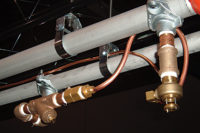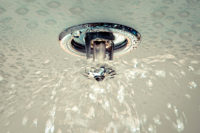Several formulas were explained in Part 1 of this article, based on NFPA Code 2001, "Standard on Clean Agent Fire Extinguishing Systems." Those formulas should be used to determine the values for the following calculations for designing a fire protection system using FM 200.
Design Calculation
First Trial:
Step 1: Reference Table 1: "Agent Quantity": Agent quantity is initially calculated per the formula in Clause 3.5.1 of NFPA 2001. Calculate the agent quantity at three temperatures-minimum, normal and maximum temperatures. Agent quantity derived is maximum at the minimum temperature and is considered for further calculation.
Step 2: Reference Table 2: "FM 200 Level on Discharge": Initial concentration of the agent is derived based on the agent quantity arrived at from Table 1. This is done for three temperatures as noted: minimum, normal and maximum. Initial agent concentration is maximum at the maximum temperature of the protected space. The initial concentration changes due to the change in the specific vapor volume of the agent at different temperatures.
Step 3: Reference Table 3: "Leakage Rate Estimate": This is estimated at three different ambient temperatures: minimum, normal and maximum. However, FM 200 vapor density is considered at 21 degrees C.
Step 4: Reference Table 4: "Leakage Area Estimate": Calculate the leakage areas.
Step 5: Reference Table 5: "Hold Time Estimate": Calculate Hold Time at three temperatures: minimum, normal and maximum. Hold Time is minimum at the minimum temperature. A check is provided that in no case should the Hold Time be less than 10 minutes, which is considered as the generic acceptable minimum Hold Time when no specific time for the type of fire is available from the AHJ.
Step 6: Reference Table 6: "Leakage Quantity Estimate": Calculate the leakage quantity based on the leakage rate, leakage area and the Hold Time. This is done for three temperatures minimum, normal, and maximum. The leakage quantity is maximum at the minimum temperature.
Observation: The agent quantity considered per Table 1 is not sufficient to take care of the leakage quantity at the minimum temperature. The agent quantity is to be jacked up to provide the leakage quantity.
Second Trial:
Step 1: Reference Table 1: "Agent Quantity": Agent quantity is toggled up to get the value of nearly zero at minimum temperature in column 14 ("Capacity margin available over leakage quantity") of Table 6. This shows that the quantity is now sufficient to provide the leakage at the minimum temperature. Agent quantity derived at the minimum temperature is accepted as the quantity to be provided for extinguishing the fire.
Step 2: Reference Table 2: Check the initial concentration based on new agent quantity derived. It is maximum at the maximum temperature. Compare the concentration level with the recommended level at NOAEL. The initial concentration at the normal temperature is compared with the acceptable level (NOAEL) in NFPA code, as the normal temperature is the predominant temperature in the space. The concentration level is preferred to be within the limit specified for NOAEL. A Concentration level higher than NOAEL but less than LOAEL is sometimes acceptable for the space normally not occupied by personnel. In case the concentration exceeds the value, solicit approval from the AHJ.
Cylinder Numbers
The authorized system designer generally finalizes cylinder numbers. The numbers depend on the fill density in the cylinder required to provide adequate pressure for the discharge of the agent from the cylinders to overcome the pressure drop through the piping and the nozzles for even distribution of the agent in the protected space. The owner's tentative piping layout and the nozzle locations are finalized by the system authorized designer based on the pressure drop of the two-phase flow of the agent through the piping per the software available with them and for even distribution of the agent in the space. The pressure drop is harmonized with the fill density of the cylinder selected and the number of cylinders. However, for budgetary purposes, the number of cylinders may be estimated as follows:
Step 1: Prepare the tentative layout of the piping, locating the nozzles for even distribution of the agent throughout the protected area. Consider the pipe sizes based on the authorized agent system designer's suggested pipe sizes against flow through the piping, which is available from their catalog cuts. Calculate the pressure drop through the piping per the procedures recommended in the SFPE Handbook [Refer to "Flow Calculations" for Halon Design Calculation in Chapter 4 (Design Calculations)]. Though the formula is referred to for halon only, the same formula may be used for FM 200, an alternative agent to halon, for estimation purpose. Check that the pressure available at the tips of the nozzles is sufficient for the discharge of the agent. Occasional feedback from the authorized agent is suggested to estimate the pressure drop through the system.
Step 2: After following the above procedure, which requires pre-selection of the fill pressure of the cylinders to get adequate pressure at the nozzle tips, select the tentative number of cylinders. Filling density in the cylinder should not exceed 70 lbs/cu.-ft. Normally in a cylinder, it varies from 35-40 lbs/cu.-ft. to 70 lbs/cu.-ft.
Summary
The agent quantity may need to be rounded to whole numbers to be divisible by the total number of cylinders. All the steps from 1 through 6 are to be recalculated based on the final agent quantity to get the final values.Example:
Here is a typical example for calculating the agent quantity for protection of a volume.
"A room of 400 m2 area with ceiling height of 3 m (up to suspended ceiling) is protected with FM 200. The design concentration of the agent is 7.44%. The room has two double doors of dimension 2.1 m x 1.8 m and a single door of 2.1 m x 0.9 m size. The size of the return duct and the supply duct of the hvac system is 0.8 m x 0.8 m and 0.7 m x 0.7 m, respectively. The hvac duct volume up to the first isolation damper is assumed as 5% of the room volume. The temperatures inside the room are considered as 0 C minimum, 24 C normal and 54 C maximum. Calculate the agent quantity for total flooding by FM 200.The site is at sea level."
Solution:
Refer to Tables 1 through 6, and follow "First Trial" and "Second Trial" instructions to find the solution.

